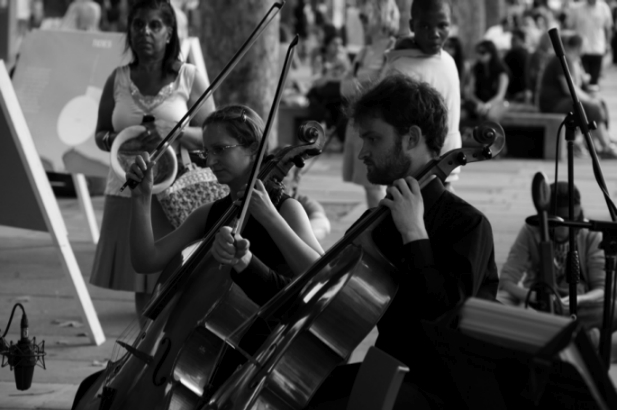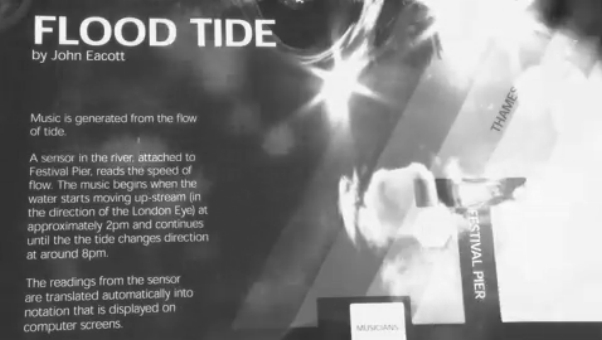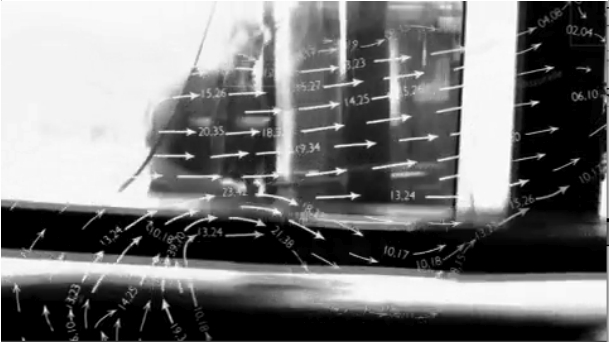MUSIC — LIVE SONIFICATION OF THE WATER FLOWaccess to the project : http://www.informal.org/ — http://floodtide.eu/ — https://floodtidemusic.wordpress.com/ — http://www.floodtide.eu/play |
Creative team :
- John Eacott, Flood Tide composer
- Jérôme Joy, creative collaborator, sonification specialist
- Natasha Bird, project co-ordinator
- Samer Abdallah, Computer and software specialist
 |
Flood Tide is a musical performance generated by the flow of tide. Using a sensor in the water and custom software which converts the gradually changing data into notation read by musicians the resulting performance is a musical sonification of tidal flow. It is a work that has arisen from interests in music, computing and the sea.
Flood Tide is a live concert. The instruments are generally acoustic no electronic sound need be involved. At a glance it appears to be a regular concert with musicians reading a pre-composed and rehearsed score. However, the music has not been pre-composed or rehearsed, rather, it is generated by the interaction of river and computer algorithms.
Flood Tide was first performed on June 28th 2008 at Trinity Buoy Wharf, London by a quartet of 2 celli, marimba and vibraphone. There have now been 10 performances. The most recent in July 2010 at the Southbank Centre in London lasted 6 hours and involved 40 orchestral musicians, voices, taiko drummers and jazz soloists.
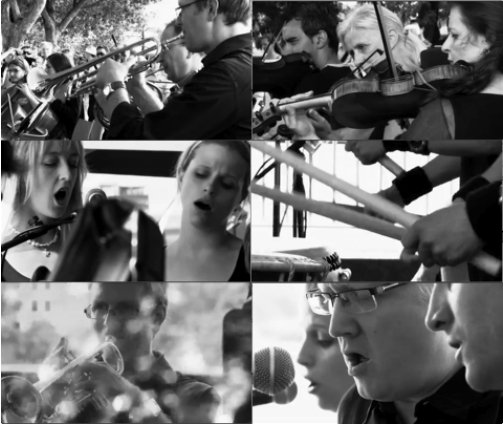 |
How Flood Tide works :(Edit)
Sensor(Edit)
Readings from water flow are taken every 5 seconds using the Nortek Vectrino Acoustic Doppler Velocimeter.
Composition algorithms(Edit)
The sensor readings are then conveted into music by applying 5 simple rules for:
- Tempo
- Rhythm
- Pitch
- Timbre
- Orchestration
Although each rule is very simple the combination and interaction of the five rules generates complex and rich results.
Live notation(Edit)
At the heart of a Flood Tide live musical sonification is a mechanism for presenting newly generated musical data as notation for musicians. The continued development of a process for live notation is an area of technical and creative input for the project.
 |
Location(Edit)
Flood Tide may be performed anywhere with tidal water and a place for musicians and audience to gather. In addition there must be:
- Cover or shelter for musicians to protect them and their instruments from weather
- Mains electricity
- Somewhere to attach the Vectrino sensor in the water
The equipment we provide includes:
- Vectrino sensor, mountings and connections
- MacPro computer
- 20 flat screen displays sufficient for an ensemble of 40
Performer requirements(Edit)
Instruments(Edit)
Practically any combination of western orchestral instruments may be used and may depend on the acoustic of the space, the kind of event and the availability of musicians. Other instrumental groups that have been used successfully include voices, Japanese Taiko drummers and jazz soloists.
As the LiveNotation system is adaptable it is envisaged that performances with practically any kind of instrument may be included.
Performer ability(Edit)
Although Flood Tide was conceived as a work for professional orchestra we have discovered that it can be adapted for a wide range of abilities including youth groups, amateurs and top professionals. The performance will be structured depending on the kind of event and musicians available to ensure that none is made to play anything that is too difficult or for too long.
Previous events(Edit)
- Flood Tide 10 - See Further, Southbank, London 4th July 2010 - with an ensemble of 40 orchestral musicians, voices, taiko drums and jazz soloists.
- Flood Tide 9 - Thames Festival 2009, London Bridge City Pier, London 14th September 2009 - with an ensemble of 31 orchestral musicians, voices and taiko drums.
- Flood Tide 7 & 8 - Moon Weekend, Royal Observatory Greenwich, London 25th and 26th July 2009 - with a sextet of 2 celli, alto flute, bass clarinet, marimba and vibraphone.
- Flood Tide 5 & 6 - Stratford Upon Avon River Festival, Stratford Upon Avon, 4th and 5th July 2009 - featuring a sextet of musicians from the Royal Shakespeare Company.
- Flood Tide 3 & 4 - Trinity Buoy Wharf, London, 20th and 21st September 2008 - with a quartet of 2 celli, marimba and vibraphone.
- Flood Tide 1 & 2 - Trinity Buoy Wharf, London, 28th and 29th June 2008 - with a quartet of 2 celli, marimba and vibraphone.
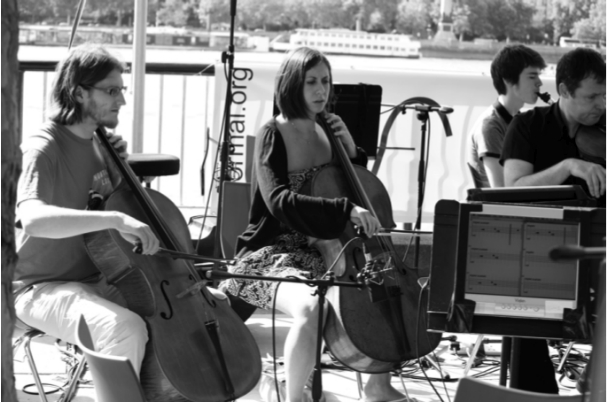 |
Nortek sponsorship(Edit)
Flood Tide is now sponsored by Nortek who provide state of the art tide measuring sensors for use in performances.
Artists(Edit)
John Eacott(Edit)
Dr. John Eacott is a trumpeter and composer whose career started in the 1980s with anarchic jazzers Loose Tubes and post-industrial metal bashers Test Dept. In the 1990s he focused on composing works for Theatre including the worldwide touring production of Gormenghast for the David Glass Ensemble and arrangements for the RSC production of Timon of Athens. Film scores include the Miramax feature Three Steps to Heaven (1995), Escape to Life with Vanessa Redgrave (2000) and jazz arrangements for Alfie starring Jude Law (2003). His orchestral compositions have been performed and recorded by the Scottish Chamber Orchestra and Docklands Sinfonietta. Previous algorithmic / generative works include The Street, an interactive sound environment (2000), Morpheus, a CD Rom of generative electronica (2001), and Intelligent Street, a sound space in which users alter their sound environment by sending text messages (2003). Since the completion of his PhD in 2007, John composed Flood Tide and Hour Angle, which are accessible live performances using algorithmic composition which have been performed many times including 2009 Thames Festival and See Further Festival at the Southbank, London 2010. He is Lecturer in Music at the University of Westminster.
Natasha Bird(Edit)
Natasha Bird graduated with first class honours in Fine Art from Camberwell College of Arts in 2008. She has organised several multi-disciplinary exhibitions in London over the last three years, including their curation, press and finance. She was also responsible in 2008 for co-managing the budget and administration of an art catalogue for 250 students. Most recently she has been working with London organisation Field, assisting with proposals for their forthcoming exhibition and residency programme. Natasha has been co-ordinating the Informal projects for the last two years, handling administration and finances. Her own practice focuses on sound-based sculpture.
